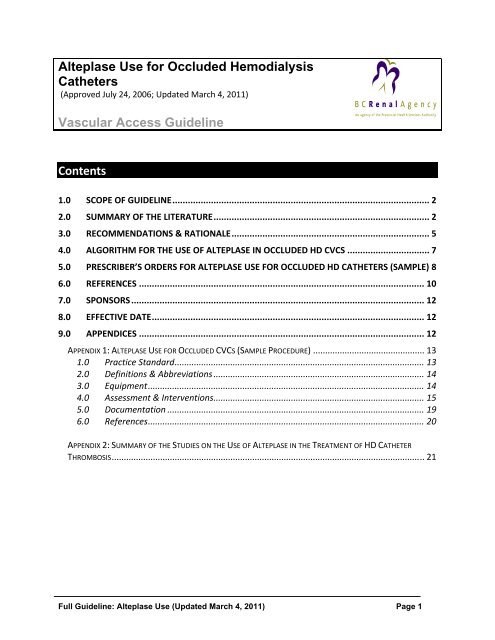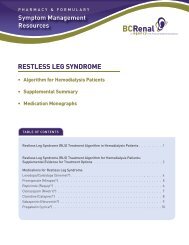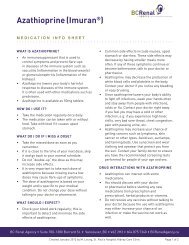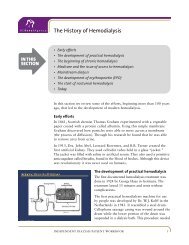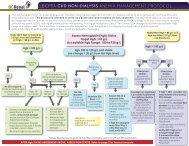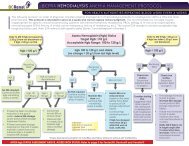Alteplase Use for Occluded Hemodialysis Catheters Vascular ...
Alteplase Use for Occluded Hemodialysis Catheters Vascular ...
Alteplase Use for Occluded Hemodialysis Catheters Vascular ...
You also want an ePaper? Increase the reach of your titles
YUMPU automatically turns print PDFs into web optimized ePapers that Google loves.
<strong>Alteplase</strong> <strong>Use</strong> <strong>for</strong> <strong>Occluded</strong> <strong>Hemodialysis</strong><br />
<strong>Catheters</strong><br />
(Approved July 24, 2006; Updated March 4, 2011)<br />
<strong>Vascular</strong> Access Guideline<br />
Contents<br />
1.0 SCOPE OF GUIDELINE .................................................................................................... 2<br />
2.0 SUMMARY OF THE LITERATURE .................................................................................... 2<br />
3.0 RECOMMENDATIONS & RATIONALE ............................................................................. 5<br />
4.0 ALGORITHM FOR THE USE OF ALTEPLASE IN OCCLUDED HD CVCS ................................ 7<br />
5.0 PRESCRIBER’S ORDERS FOR ALTEPLASE USE FOR OCCLUDED HD CATHETERS (SAMPLE) 8<br />
6.0 REFERENCES ............................................................................................................... 10<br />
7.0 SPONSORS .................................................................................................................. 12<br />
8.0 EFFECTIVE DATE .......................................................................................................... 12<br />
9.0 APPENDICES ............................................................................................................... 12<br />
APPENDIX 1: ALTEPLASE USE FOR OCCLUDED CVCS (SAMPLE PROCEDURE) .............................................. 13<br />
1.0 Practice Standard ....................................................................................................... 13<br />
2.0 Definitions & Abbreviations ....................................................................................... 14<br />
3.0 Equipment .................................................................................................................. 14<br />
4.0 Assessment & Interventions ....................................................................................... 15<br />
5.0 Documentation .......................................................................................................... 19<br />
6.0 References .................................................................................................................. 20<br />
APPENDIX 2: SUMMARY OF THE STUDIES ON THE USE OF ALTEPLASE IN THE TREATMENT OF HD CATHETER<br />
THROMBOSIS ................................................................................................................................. 21<br />
Full Guideline: <strong>Alteplase</strong> <strong>Use</strong> (Updated March 4, 2011) Page 1
<strong>Alteplase</strong> <strong>Use</strong> <strong>for</strong> <strong>Occluded</strong> HD <strong>Catheters</strong><br />
<strong>Alteplase</strong> <strong>Use</strong> <strong>for</strong> <strong>Occluded</strong> <strong>Hemodialysis</strong> <strong>Catheters</strong><br />
This guideline is intended <strong>for</strong> adults and <strong>for</strong> children weighing over 10 kilograms. For children<br />
weighing less than or equal to 10 kilograms, the concentration and dosage need to be adjusted.<br />
1.0 Scope of Guideline<br />
This guideline provides recommendations <strong>for</strong> the use of thrombolytic alteplase (Cathflo TM1 ) to<br />
maintain catheter patency.<br />
A well functioning vascular access is a prerequisite <strong>for</strong> hemodialysis (HD). To be consistent with<br />
national and international standards, the Provincial <strong>Vascular</strong> Access Service Team (PVAST) has<br />
identified the preferred <strong>for</strong>m of HD vascular access as the native arterio venous fistula (AVF),<br />
followed by the artificial arteriovenous graft (AVG) and lastly the central venous catheter (CVC).<br />
Despite all best ef<strong>for</strong>ts <strong>for</strong> patients undergoing HD to have an AVF (preferred) or AVG (2 nd choice),<br />
there will always be patients that receive HD by CVC on a temporary or permanent basis. The most<br />
common complications of CVCs are thrombosis and infection (Develter, 2005 and Little, 2001). Even<br />
with care, fewer than half the catheters placed as “long‐term accesses” are in use a year after<br />
placement (Ponikvar, 2005) and about a third are removed because they fail to deliver adequate<br />
blood flow (K/DOQI 2006).<br />
The initial approach to treatment of a dysfunctional or blocked catheter is conservative – rule out<br />
mechanical issues such as machine problems or kinks in the catheter and <strong>for</strong>cefully flush the lines<br />
with normal saline. If conservative measures fail, the administration of thrombolytic agents may be<br />
required.<br />
2.0 Summary of the Literature<br />
<strong>Use</strong> of recombinant tissue plasminogen activators (rTPAs) (alteplase, reteplase or tenecteplase)<br />
Mokrzycki and Lok (2010) reviewed the literature on the use of recombinant TPAs (alteplase,<br />
reteplase or tenecteplase) <strong>for</strong> the treatment of thrombosis in CVCs between 1993 and 2010. The<br />
short‐term success rate ranged from 40% to 92% in the 18 studies reviewed. None of the trials<br />
compared the effects between the three different TPAs.<br />
Mokrzycki and Lok stratified the 18 studies according to method of instillation: push / pause<br />
method, dwell (short and long‐term) and / or infusion. They noted that:<br />
� None of the trials compared the push / pause method and the short or long dwell method.<br />
� Dwell time did not significantly impact short‐term or 2‐week patency rates in the two trials<br />
where this was studied (Nguyen, 2004 and MacRae, 2005).<br />
� The success rate diminished with each subsequent dose of rTPA.<br />
1 <strong>Alteplase</strong>, the generic name, is used throughout the remainder of the document.<br />
Full Guideline: <strong>Alteplase</strong> <strong>Use</strong> (Updated March 4, 2011) Page 2
<strong>Alteplase</strong> <strong>Use</strong> <strong>for</strong> <strong>Occluded</strong> HD <strong>Catheters</strong><br />
Success rates by method of instillation:<br />
Push / pause method (4 studies):<br />
� Short‐term: 59% – 92%.<br />
� Long‐term: 60% patency at 30 days<br />
Short dwell (6 clinical trials; dwell time
<strong>Alteplase</strong> <strong>Use</strong> <strong>for</strong> <strong>Occluded</strong> HD <strong>Catheters</strong><br />
Author Dose Method ST Success LT Success<br />
O’ Mara et al 1 mg / ml, dose Short dwell 69% Time to next tx: 12.5 d<br />
(2003) det’d by lumen vol<br />
(mean)<br />
Zacharias et al 1 mg / ml, dose Push / pause 85% (fully 60% patency at 30<br />
(2003) det’d by lumen vol<br />
occluded) – 92%<br />
(partially occluded)<br />
days<br />
Little et al 1 mg / ml, dose Long dwell 10% of catheters 34% patency at 1 yr<br />
(2002) det’d by lumen vol<br />
required alteplase<br />
Eyrich et al<br />
(2002)<br />
1 mg / lumen Push / pause 86% Not specified<br />
Savader et al 2.5 mg / lumen Infusion (3 91% 55% patency at 30<br />
(2001)<br />
hours)<br />
days<br />
Spry (2001) 1 mg / ml, dose<br />
det’d by lumen vol<br />
Push / pause 59% Not specified<br />
Daeihagh et al<br />
(2000)<br />
2 mg / lumen Long dwell 88% Not specified<br />
Meers et al 1 mg / lumen Push / pause & 97% Time to next tx: 30 d<br />
(1999)<br />
/ or long dwell<br />
(mean)<br />
Success rates:<br />
� Definitions of “success” differed between studies. Common definitions included:<br />
� Short‐term success: blood pump speeds of 250 – 300 mL / min and / or the ability to initiate<br />
dialysis.<br />
� Long‐term success: the time from the first course to the next course of alteplase treatment<br />
and / or catheter patency and / or survival.<br />
� Short‐term success rates ranged from 59% ‐ 100%.<br />
� The time from the first course to the next course of alteplase ranged from 12.5 – 30 days.<br />
Patency rates ranged from 54% to 60% at 30 days.<br />
Method of instillation<br />
� There was no obvious correlation between method of instillation and success.<br />
� This finding was similar to that reported in two systematic review articles (Mokrzycki and Lok,<br />
2010 and Lok, 2006).<br />
Dosages:<br />
� For the push / pause and dwell methods, dosages ranged from 1 – 2 mg / lumen. There was no<br />
obvious correlation between dosage and success.<br />
� For the infusion methods, the dosage ranged from 4 – 10 mg. Again, there was no obvious<br />
correlation between dosage and success.<br />
� The observed lack of correlation between dosages and success was similar to that reported in<br />
two systematic review articles (Mokrzycki and Lok, 2010 and Lok, 2006).<br />
� Two studies reported a cost savings from the use of a lower dosage (Hamond, 2005 and<br />
Nguyen, 2004).<br />
Full Guideline: <strong>Alteplase</strong> <strong>Use</strong> (Updated March 4, 2011) Page 4
<strong>Alteplase</strong> <strong>Use</strong> <strong>for</strong> <strong>Occluded</strong> HD <strong>Catheters</strong><br />
Prevention of Catheter Lumen Occlusion with recombinant‐TPA versus heparin (Pre‐Clot) Study<br />
� The Pre‐Clot study is a randomized controlled trial evaluating the effectiveness of weekly<br />
alteplase lock <strong>for</strong> the prevention of HD catheter malfunction. Patients from 14 centres across<br />
Canada were randomized to the treatment arm received alteplase 1 mg per lumen once per<br />
week, with heparin 5,000 units per ml as a catheter locking solution <strong>for</strong> the remaining two<br />
sessions. Patients randomized to the control arm received heparin 5,000 units per ml as a<br />
catheter locking solution after each dialysis.<br />
� Preliminary results suggest that patients in the alteplase arm had significantly fewer catheter<br />
malfunctions (primary outcome) and bacteremia (secondary outcome). There were no<br />
significant differences in bleeding events between arms.<br />
� This is the first large, well‐designed trial that has studied the routine prophylactic use of<br />
alteplase lock in HD catheters. Until the details have been published, cost effectiveness has<br />
been proven and similar results replicated in other trials, the use of rTPA to prevent thrombosis<br />
is not recommended.<br />
In summary, alteplase and other rTPA medications appear to be effective as a short‐term option <strong>for</strong><br />
treating thrombosis‐related dysfunctional CVCs. Most studies do not support the use of rTPA in<br />
preventing thrombosis, nor <strong>for</strong> use on an ongoing basis unless as a last resort (no other catheter<br />
sites, maturing fistula, etc).<br />
3.0 Recommendations & Rationale<br />
Recommendation 1: Prevent and/or reduce incidences of CVC‐related thrombosis by:<br />
� Regularly assessing dialysis per<strong>for</strong>mance and early recognition of problems (see next point <strong>for</strong><br />
signs of CVC dysfunction).<br />
� Forceful flushing with normal saline pre and post dialysis and capping the CVC pre‐ and post‐<br />
dialysis with heparin or citrate.<br />
� Regularly reversing the flows (opinion) (e.g., once per week) if using Palindrome catheters.<br />
Not recommended with any other catheter.<br />
� Using of newer catheters that are capable of achieving rates of > 400 mL/min when properly<br />
placed.<br />
� Using needle‐free connectors <strong>for</strong> HD lines.<br />
Signs of CVC dysfunction include (K/DOQI, 2006):<br />
� Blood pump flow rate 250 mm Hg)<br />
� Ratio of blood pump flow to the absolute value of pre‐pump pressure (conductance) (
<strong>Alteplase</strong> <strong>Use</strong> <strong>for</strong> <strong>Occluded</strong> HD <strong>Catheters</strong><br />
Recommendation 2: If CVC dysfunction is identified, rule out causes other than thrombosis as the<br />
source of the dysfunction.<br />
Causes of CVC dysfunction other than thrombosis include mechanical reasons, kinks (angulation in<br />
tunnel), misplaced sutures, catheter migration, drug precipitation (some antibiotic locks or IV IgG),<br />
hypovolemia, patient position, catheter integrity, holes and cracks (KDOQI; 2006). Such causes need<br />
to be ruled out prior to the use of thrombolytics.<br />
Recommendation 3: If CVC dysfunction is related to thrombosis, administer alteplase as per<br />
physician’s order, using the algorithm (section 4.0) and pre‐printed orders (section 5.0) as a<br />
guideline.<br />
After mechanical reasons, thrombotic occlusion (partial or total) is the most common cause of<br />
catheter dysfunction and/or occlusion. Common sites of thrombus <strong>for</strong>mation are the catheter<br />
lumen, the site where the catheter enters the vein, the catheter tip and along the external surface<br />
of the catheter.<br />
<strong>Alteplase</strong> is the thrombolytic agent of choice <strong>for</strong> treating occluded HD CVCs. <strong>Alteplase</strong> works by<br />
binding to fibrin in a thrombus, then converting the entrapped plasminogen to plasmin which<br />
results in local fibrinolysis (i.e. digests fibrin and dissolves blood clot).<br />
While alteplase has proven to be useful in the management of catheter‐related thrombotic<br />
occlusions, little published evidence exists addressing the most effective method(s) of<br />
administration. Guidelines are provided in this document <strong>for</strong> the three most commonly used<br />
methods: push/pause, dwell (short and long) and infusion (simultaneous infusion method via<br />
arterial and venous lumens prior to initiating HD and single lumen method during HD). Selection of<br />
the method will depend on individual circumstances including the severity of the occlusion and the<br />
timing and urgency of the need <strong>for</strong> dialysis.<br />
<strong>Alteplase</strong> is an expensive medication (2 mg = $65; 4 mg = $130). It is important that its use and<br />
dosage be limited to that which is absolutely necessary. Generally speaking, a graduated dosing<br />
scheme is recommended, starting with a lower dose and increasing to a higher dose if the lower<br />
dose is not effective. This guideline provides a range of dosages to allow <strong>for</strong> this practice.<br />
Recommendation 4: Notify the physician if one or both lumens are still “sticky” or blocked after<br />
administering alteplase more than twice on two separate occasions in a 2‐week period.<br />
Recommendation 5: Chronic use of alteplase is strongly discouraged other than in exceptional<br />
circumstances (i.e., resistant CVCs) and:<br />
� CVC is the last option <strong>for</strong> HD access AND the patient is unable to tolerate further CVC<br />
replacements; OR<br />
� A maturing AVF or AVG is imminent.<br />
Full Guideline: <strong>Alteplase</strong> <strong>Use</strong> (Updated March 4, 2011) Page 6
<strong>Alteplase</strong> <strong>Use</strong> <strong>for</strong> <strong>Occluded</strong> HD <strong>Catheters</strong><br />
4.0 Algorithm <strong>for</strong> the <strong>Use</strong> of <strong>Alteplase</strong> in <strong>Occluded</strong> HD CVCs<br />
Full Guideline: <strong>Alteplase</strong> <strong>Use</strong> (Updated March 4, 2011) Page 7
<strong>Alteplase</strong> <strong>Use</strong> <strong>for</strong> <strong>Occluded</strong> HD <strong>Catheters</strong><br />
5.0 Prescriber’s Orders <strong>for</strong> <strong>Alteplase</strong> <strong>Use</strong> <strong>for</strong> <strong>Occluded</strong> HD <strong>Catheters</strong> (Sample)<br />
PRESCRIBER’S ORDERS<br />
DATE &<br />
TIME<br />
<strong>Alteplase</strong> (CATHFLO) FOR OCCLUDED HEMODIALYSIS CATHETER<br />
(items with check boxes must be selected to be ordered)<br />
** NOTE: do not premix reconstituted alteplase with sodium chloride 0.9% in same syringe **<br />
See reconstitution instructions <strong>for</strong> alteplase on reverse.<br />
If no flow or blood pump speed is less than 200 mL/min:<br />
Push/Pause Method:<br />
Instil alteplase 1 mg *OR* 2 mg into each catheter lumen then add sodium chloride 0.9% without<br />
preservative to fill the internal volume of each lumen plus 0.1 mL overfill.<br />
Attach syringe filled with sodium chloride 0.9% to each lumen. Wait 10 minutes, then gently push sodium<br />
chloride 0.9% 0.3 mL into catheter lumen. Wait another 10 minutes, then repeat sodium chloride 0.9% 0.3 mL<br />
push. Wait another 10 minutes, then aspirate clots using a 10 mL syringe and discard. May push remaining<br />
alteplase if unable to withdraw. Forcefully flush each catheter lumen as per protocol.<br />
Short Dwell Method:<br />
Instil alteplase 1 mg *OR* 2 mg into each catheter lumen then add sodium chloride 0.9% without<br />
preservative to fill the internal volume of each lumen plus 0.1 mL overfill<br />
Leave alteplase solution in situ <strong>for</strong> 60 minutes, then withdraw the solution and clot(s); may push remaining<br />
alteplase if unable to withdraw. Forcefully flush each catheter lumen as per protocol.<br />
Overnight Dwell Method:<br />
Instil alteplase 1 mg *OR* 2 mg into each catheter lumen then add sodium chloride 0.9% without<br />
preservative to fill the internal volume of each lumen plus 0.1 mL overfill<br />
Leave alteplase solution in situ until the next hemodialysis treatment. Prior to start of next treatment, withdraw<br />
the solution and clot(s); may push remaining alteplase if unable to withdraw. Forcefully flush each catheter<br />
lumen as per protocol.<br />
Simultaneous Infusion Method via arterial and venous lumens (prior to initiating hemodialysis):<br />
Infuse alteplase 1 mg *OR* 2 mg in sodium chloride 0.9% 50 mL into each catheter lumen over 30 minutes<br />
according to protocol.<br />
If blood pump speed is 200 mL/min or greater and less than 300 mL/min:<br />
Single Lumen Infusion Method during hemodialysis:<br />
Infuse alteplase 2 mg *OR* 4 mg in sodium chloride 0.9% 100 mL via the hemodialysis catheter over 60<br />
minutes according to protocol.<br />
Overnight Dwell Method as above<br />
May repeat a second dose of the above chosen method at the next HD run if one or both lumens are still<br />
“sticky” or blocked. Notify physician if a second dose is given.<br />
________________________________ _________________________________ _____________ ______<br />
Printed Name Signature College ID Pager<br />
Full Guideline: <strong>Alteplase</strong> <strong>Use</strong> (Updated March 4, 2011) Page 8
<strong>Alteplase</strong> <strong>Use</strong> <strong>for</strong> <strong>Occluded</strong> HD <strong>Catheters</strong><br />
Reconstitution instructions <strong>for</strong> alteplase<br />
Reconstitute immediately be<strong>for</strong>e use as there is no preservative in alteplase vials. The reconstituted solution<br />
may be used within 8 hours following reconstitution when stored at 3 to 30ºC.<br />
a. Reconstitution instructions <strong>for</strong> push/pause and dwell instillation methods:<br />
To prepare alteplase to a final concentration of 1 mg/mL:<br />
1. Using aseptic technique, withdraw 2.2 mL of sterile water <strong>for</strong> injection. Do not use bacteriostatic<br />
water <strong>for</strong> injection <strong>for</strong> reconstitution.<br />
2. Inject the 2.2 mL of sterile water <strong>for</strong> injection into the alteplase 2 mg vial, directing the diluent<br />
stream into the powder. Slight foaming is not unusual; let the vial stand undisturbed to allow large<br />
bubbles to dissipate.<br />
3. Mix by gently swirling until the contents are completely dissolved. Do not shake. The reconstituted<br />
preparation results in a colorless to pale yellow transparent solution containing alteplase 1 mg/mL.<br />
4. Withdraw prescribed amount of alteplase 1 mg (1 mL) or 2 mg (2 mL) of solution from the<br />
reconstituted alteplase vial.<br />
To prepare alteplase to a final concentration of 2 mg/mL (only use this strength <strong>for</strong> catheter volumes
<strong>Alteplase</strong> <strong>Use</strong> <strong>for</strong> <strong>Occluded</strong> HD <strong>Catheters</strong><br />
6.0 References<br />
Daeihagh P, Jordan J, Chen J, et al. (2000). Efficacy of Tissue Plasminogen Activator<br />
Administration on Patency of <strong>Hemodialysis</strong> Access <strong>Catheters</strong>. Am J Kid Dis,36 ():75‐79.<br />
Davies J, Casey J, Li C, et al. (2004). Restoration of Flow Following <strong>Hemodialysis</strong> Catheter<br />
Thrombus. Analysis of rt‐PA Infusion in Tunneled Dialysis <strong>Catheters</strong>. J Clin Pharm<br />
Therapeutics, 29, 517‐520.<br />
Develter W, De Cubber A, Van Biesen W, et al. (2005). Survival and Complications of<br />
Indwelling Venous <strong>Catheters</strong> <strong>for</strong> Permanent <strong>Use</strong> in <strong>Hemodialysis</strong> Patients. Artif Organs,<br />
29:399‐405.<br />
Dowling K, Sansivero G, Stainken B, et al. (2004). The <strong>Use</strong> of Tissue Plasminogen Activator<br />
Infusion to Re‐establish Function of Tunneled <strong>Hemodialysis</strong> <strong>Catheters</strong>. Nephrol Nurs J,<br />
31:199‐200.<br />
Eyrich H, Walton T, Macon EJ et al. (2002). <strong>Alteplase</strong> versus Urokinase in Restoring Blood<br />
Flow in <strong>Hemodialysis</strong>‐Catheter Thrombosis. Am J Health‐Syst Pharm;59:1437‐1440.<br />
Haymond J, Shalansky K, Jastrzebski J (2005). Efficacy of Low‐dose <strong>Alteplase</strong> <strong>for</strong> Treatment<br />
of <strong>Hemodialysis</strong> Catheter Occlusions. J Vasc Access 6:76‐82.<br />
Little MA, O’Riordan A, Lucey B, et al. (2001). A Prospective Study of Complications<br />
Associated with Cuffed, Tunneled <strong>Hemodialysis</strong> <strong>Catheters</strong>. Nephrol Dial Transplant,<br />
16:2194‐2200.<br />
Lok, C, et. al. (2006). A Patient‐Focused Approach to Thrombolytic <strong>Use</strong> in the Management<br />
of Catheter Malfunction. Sem in Dial, 19 (5):381‐390.<br />
MacRae, JM, Loh G., Djurdjiev O, Shalansky S, Werb R., Levin A, Kiaii M. (2005). Short and<br />
Long <strong>Alteplase</strong> Dwells in Dysfunctional <strong>Hemodialysis</strong> <strong>Catheters</strong>: Hemodial Int, 9: 189‐195.<br />
Meers C, Toffelmire EB. (1999). Tissue Plasminogen Activator (t‐PA) Efficacy in the<br />
Restoration of <strong>Hemodialysis</strong> Catheter Function. CANNT J 9:25‐28.<br />
Mokrzycki M, Lok C. (2010). Traditional and Non‐Traditional Strategies to Optimize Catheter<br />
Function: Go With More Flow. Kid Int, 78: 1218‐1231.<br />
National Kidney Foundation. (2006). KDOQI Clinical Practice Guidelines and Clinical Practice<br />
Recommendations <strong>for</strong> 2006 Updates: <strong>Hemodialysis</strong> Adequacy, Peritoneal Dialysis Adequacy<br />
and <strong>Vascular</strong> Access. Am J Kidney Dis, 48 (suppl 1):S1‐S322.<br />
Nguyen TV, Dikun M. (2004). Establishing an <strong>Alteplase</strong> Dosing Protocol <strong>for</strong> <strong>Hemodialysis</strong>‐<br />
Catheter Thrombosis. Am J Health‐Syst Pharm, 61:1922‐1924.<br />
Full Guideline: <strong>Alteplase</strong> <strong>Use</strong> (Updated March 4, 2011) Page 10
<strong>Alteplase</strong> <strong>Use</strong> <strong>for</strong> <strong>Occluded</strong> HD <strong>Catheters</strong><br />
O'Mara NB, Ali S, Bivens K, et al. (2003). Efficacy of Tissue Plasminogen Activator <strong>for</strong><br />
Thrombolysis in Central Venous Dialysis <strong>Catheters</strong>. Hemodial Int 7 (2):130‐134.<br />
Ponikvar R, Buturovic‐Ponikvar J. (2005). Temporary <strong>Hemodialysis</strong> <strong>Catheters</strong> as a Long‐term<br />
<strong>Vascular</strong> Access in Chronic <strong>Hemodialysis</strong> Patients. Ther Apher Dial, 9:250‐253.<br />
Providence Health Care. (2009). Prescriber’s Orders <strong>for</strong> <strong>Alteplase</strong> (CATHFLO) <strong>for</strong> <strong>Occluded</strong> HD<br />
<strong>Catheters</strong>.<br />
Savader SJ, Haikal LC, Ehrman KO, et al. (2001). Treatment of <strong>Hemodialysis</strong> Catheter‐<br />
associated Fibrin Sheaths by rt‐PA Infusion: Critical Analysis of 124 Procedures. J Vasc Interv<br />
Radiol, 12:711‐715.<br />
Spry LA, Miller G. (2001). Low‐Dose tPA <strong>for</strong> <strong>Hemodialysis</strong> Catheter Clearance. Dial<br />
Transplant, 30:10‐12,54.<br />
Zacharias JM, Weatherston CP, Spewak CR, et al. (2003). <strong>Alteplase</strong> Versus Urokinase <strong>for</strong><br />
<strong>Occluded</strong> <strong>Hemodialysis</strong> <strong>Catheters</strong>. Ann Pharmacother, 37:27‐33.<br />
Full Guideline: <strong>Alteplase</strong> <strong>Use</strong> (Updated March 4, 2011) Page 11
<strong>Alteplase</strong> <strong>Use</strong> <strong>for</strong> <strong>Occluded</strong> HD <strong>Catheters</strong><br />
7.0 Sponsors<br />
This provincial guideline was developed to support improvements in the quality of vascular access<br />
care delivered to patients with chronic kidney disease in BC. Based on the best in<strong>for</strong>mation<br />
available at the time it was published, the guideline relies on evidence and avoids opinion‐based<br />
statements where possible. When used in conjunction with pertinent clinical data, it is a tool that<br />
health authorities and health professionals can use to develop local guidelines.<br />
Developed by a <strong>Vascular</strong> Access Working Group of multidisciplinary care providers from across BC,<br />
the guideline was approved by the Provincial <strong>Vascular</strong> Access Services Team, the BCPRA Pharmacy<br />
and Formulary Committee (Jan 17, 2011) and the BC Provincial Renal Agency Medical Advisory<br />
Committee (Jan 21, 2011. It has been adopted by BCPRA as a provincial guideline.<br />
8.0 Effective Date<br />
� March 4, 2011.<br />
� Refer to www.bcrenalagency.ca <strong>for</strong> most recent version.<br />
9.0 Appendices<br />
Appendix 1: <strong>Alteplase</strong> <strong>Use</strong> <strong>for</strong> <strong>Occluded</strong> CVCs (Sample Procedure)<br />
Appendix 2: Summary of the Studies on the <strong>Use</strong> of <strong>Alteplase</strong> in the Treatment of HD Catheter<br />
Thrombosis<br />
Full Guideline: <strong>Alteplase</strong> <strong>Use</strong> (Updated March 4, 2011) Page 12
<strong>Alteplase</strong> <strong>Use</strong> <strong>for</strong> <strong>Occluded</strong> HD <strong>Catheters</strong><br />
Appendix 1: <strong>Alteplase</strong> <strong>Use</strong> <strong>for</strong> <strong>Occluded</strong> CVCs (Sample Procedure)<br />
1.0 Practice Standard<br />
Skill Level (Nursing): Specialized<br />
Registered nurses who have completed the required hemodialysis (HD) specialty education and<br />
who provide care in a BC In‐Centre and/or Community Renal Program may per<strong>for</strong>m this procedure,<br />
upon the order of a physician.<br />
Need to Know<br />
1. <strong>Use</strong> of alteplase in occluded hemodialysis central venous catheters (CVCs) requires a physician’s<br />
order.<br />
2. Blocked or dysfunctional central venous catheters are identified by: difficulty instilling or<br />
aspirating catheter lumens, a blood pump speed of
<strong>Alteplase</strong> <strong>Use</strong> <strong>for</strong> <strong>Occluded</strong> HD <strong>Catheters</strong><br />
10. <strong>Alteplase</strong> vials need to be protected from light and kept in their original box until needed.<br />
<strong>Alteplase</strong> vials do not contain antibacterial preservatives and should be stored in a refrigerator<br />
at a temperature between 2 and 8 degrees C and reconstituted immediately be<strong>for</strong>e use. The<br />
solution must be used within 8 hours following reconstitution when stored between 2 and 30<br />
degrees C.<br />
11. <strong>Alteplase</strong> must be reconstituted with Sterile Water <strong>for</strong> injection. Do not shake vial to dissolve.<br />
12. Heparin / sodium citrate and alteplase are incompatible when mixed together; there<strong>for</strong>e, if<br />
heparin is used to lock the catheter, the heparin must be aspirated or flushed from the catheter<br />
lumens prior to the instillation of alteplase.<br />
13. Common sites of thrombus <strong>for</strong>mation; catheter lumen, site where catheter enters the vein,<br />
catheter tip and along the external surface of the catheter.<br />
2.0 Definitions & Abbreviations<br />
<strong>Alteplase</strong> Recombinant tissue plasminogen activator, rtPA, Cathflo TM<br />
CVC Central venous catheter<br />
HD <strong>Hemodialysis</strong><br />
3.0 Equipment<br />
Push/pause and dwell methods:<br />
� 1 or 2 vials alteplase with 2 mg/vial<br />
� 1 or 2 vials of sterile water <strong>for</strong> injection (do not use bacteriostatic water <strong>for</strong> injection)<br />
� 4 x 3 mL luer lock syringes with needles (2 <strong>for</strong> alteplase and 2 <strong>for</strong> sodium chloride 0.9%)<br />
� 2 x 10 mL luer lock syringes (to withdrawal old anticoagulant and clot from lumens)<br />
� 4 x 10 mL or 2 x 20 mL luer lock syringes with sodium chloride 0.9% (to flush lumens)<br />
� 2 luer lock caps (to cap off lumens)<br />
� 2 medication labels<br />
� Chlorhexidine gluconate 2% aqueous or per unit protocol<br />
IV infusion method:<br />
� 1 or 2 vials alteplase with 2 mg/vial<br />
� 1 or 2 vials of sterile water <strong>for</strong> injection (do not use bacteriostatic water <strong>for</strong> injection)<br />
� 2 or 3 x 3 mL luer lock syringes<br />
� 1 or 2 x 18g needles<br />
� Chlorhexidine gluconate 2% aqueous or per unit protocol<br />
� 1 or 2 medication labels<br />
� 1 or 2 minibags containing sodium chloride 0.9% (50 ml or 100 mL)<br />
� 1 or 2 volumetric infusion pumps and tubing<br />
� “Y” luer lock adaptor<br />
Full Guideline: <strong>Alteplase</strong> <strong>Use</strong> (Updated March 4, 2011) Page 14
<strong>Alteplase</strong> <strong>Use</strong> <strong>for</strong> <strong>Occluded</strong> HD <strong>Catheters</strong><br />
4.0 Assessment & Interventions<br />
Separate sub‐procedures are identified <strong>for</strong> each of the three methods of administration:<br />
1. Dwell (short & long);<br />
2. Push/pause; and<br />
3. Infusion (single lumen method during HD & simultaneous infusion method via arterial and<br />
venous lumens prior to initiating HD).<br />
4.1 Preparation <strong>for</strong> All Administration Methods<br />
1. Prior to initiating each dialysis treatment, attempt to aspirate the heparin/sodium citrate from<br />
each lumen of the CVC with a 10 mL syringe using aseptic technique.<br />
2. If aspiration is unsuccessful, attempt to <strong>for</strong>cefully flush each lumen as follows:<br />
a. Draw sodium chloride 0.9% in 2 x 10 mL or 1 x 20 mL luer‐lock syringe(s) <strong>for</strong> each CVC<br />
lumen.<br />
b. Flush each catheter port with a total of 20 mL sodium chloride 0.9% using maximum <strong>for</strong>ce.<br />
3. If flush is successful, attempt to aspirate blood and per<strong>for</strong>m 2 – 3 additional <strong>for</strong>ceful flushes<br />
with aspirated blood.<br />
4. If flush is unsuccessful, repeat step 2; if still unsuccessful, contact the physician.<br />
5. Prepare alteplase as per physician order, the product monograph and the reconstitution<br />
procedure on the reverse side of the pre‐printed orders.<br />
4.2 <strong>Alteplase</strong> Administration<br />
4.2.1 Dwell (Short & Long) Method<br />
1. Follow steps 1 to 5 under “Preparation <strong>for</strong> All Administration Methods.”<br />
2. Clean stopper with alcohol swab. Using 3 mL syringes with needles, withdraw the alteplase<br />
solution.<br />
a. If using alteplase 1 mg per lumen, draw 1 mL of alteplase 1 mg/mL solution into each of two<br />
3 mL syringes (label carefully). Fill two additional 3 mL syringes with sufficient sodium<br />
chloride 0.9% to fill the internal volume of each CVC lumen plus 0.1 mL overfill (e.g., if<br />
catheter volume is 2.2 mL per lumen, draw 1 mL of alteplase 1 mg/mL and 1.3 mL sodium<br />
chloride 0.9% <strong>for</strong> each lumen).<br />
b. If using alteplase 2 mg per lumen and catheter lumen volume is 2 mL or greater, draw up 2<br />
mL of alteplase 1 mg/mL solution into each of two 3 mL syringes (label carefully). Fill two<br />
additional 3 mL syringes with sufficient sodium chloride 0.9% to fill the internal volume of<br />
Full Guideline: <strong>Alteplase</strong> <strong>Use</strong> (Updated March 4, 2011) Page 15
<strong>Alteplase</strong> <strong>Use</strong> <strong>for</strong> <strong>Occluded</strong> HD <strong>Catheters</strong><br />
each CVC lumen plus 0.1 mL overfill (e.g., if dose is 2 mg alteplase per lumen and catheter<br />
volume is 2.2 mL per lumen, draw 2 mL of alteplase 1 mg/mL and 0.3 mL sodium chloride<br />
0.9% <strong>for</strong> each lumen).<br />
c. If using alteplase 2 mg per lumen and catheter lumen volume is less than 2 mL, draw up 1<br />
mL of alteplase 2 mg/mL solution into each of two 3 mL syringes (label carefully). Fill two<br />
additional 3 mL syringes with sufficient sodium chloride 0.9% to fill the internal volume of<br />
each CVC lumen plus 0.1 mL overfill (e.g., if dose is 2 mg alteplase per lumen and catheter<br />
volume is 1.3 mL per lumen, draw 1 mL of alteplase 2 mg/mL and 0.4 mL sodium chloride<br />
0.9% <strong>for</strong> each lumen).<br />
3. Clamp both lumens and then attach the 3 mL syringe(s) filled with alteplase to the occluded CVC<br />
port(s).<br />
4. Instil alteplase as per order into the each of the arterial and venous lumens of the CVC then add<br />
sodium chloride 0.9% without preservative to fill the internal volume of each lumen plus 0.1 mL<br />
overfill.<br />
5. Clamp both lumens.<br />
For Short (Pre‐dialysis) Dwells:<br />
a. Leave the alteplase solution instilled in the catheter <strong>for</strong> at least 30 minutes but preferably<br />
60 minutes, unless otherwise ordered by the physician.<br />
b. Withdraw the alteplase solution and residual clot from both lumens and discard. If unable to<br />
withdraw alteplase solution, try to re‐position the catheter or patient to aid in the<br />
withdrawal.<br />
c. Attempt to flush the CVC with sodium chloride 0.9% using the <strong>for</strong>ceful flush protocol<br />
described under “Preparation <strong>for</strong> All Administration Methods”.<br />
d. If one or both lumens are still “sticky” or blocked, repeat administration of alteplase. If still<br />
“sticky” or blocked after administering alteplase twice on two separate occasions within a<br />
two week period, notify the physician <strong>for</strong> further orders.<br />
For Long (Overnight) Dwells:<br />
a. Remove the emptied 3 mL alteplase or sodium chloride 0.9% syringe from each lumen and<br />
secure a luer lock cap.<br />
b. When patient returns <strong>for</strong> the next HD treatment:<br />
i. Withdraw the alteplase solution and residual clot from both lumens and discard. If<br />
unable to withdraw alteplase solution, try to re‐position the catheter or patient to aid<br />
in the withdrawal.<br />
Full Guideline: <strong>Alteplase</strong> <strong>Use</strong> (Updated March 4, 2011) Page 16
<strong>Alteplase</strong> <strong>Use</strong> <strong>for</strong> <strong>Occluded</strong> HD <strong>Catheters</strong><br />
ii. Attempt to flush the CVC with sodium chloride 0.9% using the <strong>for</strong>ceful flush protocol<br />
described under “Preparation <strong>for</strong> All Administration Methods”.<br />
iii. If one or both lumens are still “sticky” or blocked, repeat administration of alteplase. If<br />
still “sticky” or blocked after administering alteplase twice on two separate occasions<br />
within a two week period, notify the physician <strong>for</strong> further orders.<br />
4.2.2 Push/Pause Method<br />
1. Follow steps 1 to 5 under “Preparation <strong>for</strong> All Administration Methods” and step 2 under the<br />
instructions <strong>for</strong> dwell (short & long) method <strong>for</strong> drawing up the syringes.<br />
2. Clamp both lumens and then attach the 3 mL syringe(s) filled with alteplase to the occluded CVC<br />
port(s).<br />
3. Instill alteplase as per order into each catheter lumen then add sodium chloride 0.9% without<br />
preservative to fill the internal volume of each lumen plus 0.1 mL overfill.<br />
4. Attach a 3 mL syringe filled with sodium chloride 0.9% without preservative to each lumen.<br />
5. Wait 10 minutes, then gently push sodium chloride 0.9% 0.3 mL..<br />
6. Wait another 10 minutes, then repeat sodium chloride 0.9% push as above.<br />
7. Wait another 10 minutes, then use a 10 mL syringe to aspirate any clots and discard; may push<br />
remaining alteplase if unable to withdraw. Forcefully flush each catheter lumen as per protocol.<br />
8. If one or both lumens are still “sticky” or blocked, repeat administration of alteplase. If still<br />
“sticky” or blocked after administering alteplase twice on two separate occasions within a two<br />
week period, notify the physician <strong>for</strong> further orders.<br />
4.2.3 Infusion Method<br />
For Infusion of <strong>Alteplase</strong> through a Single Lumen During <strong>Hemodialysis</strong><br />
Scenario:<br />
� One catheter lumen provides a minimum blood flow of 200 mL/min.<br />
� One catheter lumen does not provide adequate blood flow, however, alteplase can be<br />
administered through this lumen.<br />
1. Follow steps 1 to 5 under “Preparation <strong>for</strong> All Administration Methods.”<br />
2. Prepare alteplase infusion:<br />
� Add alteplase in the amount ordered by the physician to the 100 mL sodium chloride 0.9%<br />
minibag <strong>for</strong> infusion and label the minibag.<br />
Full Guideline: <strong>Alteplase</strong> <strong>Use</strong> (Updated March 4, 2011) Page 17
<strong>Alteplase</strong> <strong>Use</strong> <strong>for</strong> <strong>Occluded</strong> HD <strong>Catheters</strong><br />
� Connect the infusion tubing to one limb of the “Y” adapter.<br />
� Prime the infusion pump tubing and “Y” adapter.<br />
3. Connect arterial blood‐line to the catheter lumen that provides adequate blood flow. Prime<br />
circuit with blood as per procedure to initiate HD.<br />
4. Connect the venous blood‐line to the “Y” adapter and then connect the male end of the “Y”<br />
adapter to the problematic lumen of the catheter. blood‐line<br />
5. Initiate dialysis as per routine.<br />
6. Commence alteplase infusion to run over 1 hour.<br />
7. Monitor and document q 15 min: vital signs and signs and symptoms of adverse complications<br />
(e.g., bleeding or allergic reaction).<br />
8. After 30 min of alteplase infusion, consider switching lines to prophylactically administer<br />
alteplase through the opposite lumen as follows:<br />
� Stop blood pump and infusion pump.<br />
� Using aseptic technique, disconnect and switch arterial blood‐line and “Y” adapter with<br />
venous blood‐line.<br />
If lines are not switched, continue infusion into the same line <strong>for</strong> 60 minutes.<br />
9. Restart blood pump and infusion pump.<br />
10. Observe and document blood pump speed and arterial and venous pressures. Continue dialysis<br />
treatment.<br />
�Key point: A blood pump speed of 300 mL or more per minute with corresponding arterial<br />
and venous pressures is an indication of successful fibrinolysis.<br />
11. In the event that adequate blood pump speeds are not attainable after switching the lines (i.e.,<br />
more than 300 mL per minute), stop blood pump and infusion pump. Using aseptic technique,<br />
switch the arterial blood‐line and “Y” adapter with the venous blood‐line to resume the<br />
alteplase infusion through the problematic lumen. Repeat vital signs. Continue dialysis<br />
treatment.<br />
12. When infusion is complete, if unable to attain blood pump speeds of greater than 300 mL/min,<br />
notify the physician.<br />
For Simultaneous Infusion of <strong>Alteplase</strong> into the Arterial and Venous Lumens Prior to Initiating HD<br />
Scenario:<br />
� One catheter lumen provides a blood flow of less than 200mL/min<br />
� Unable to initiate hemodialysis due to inadequate blood flow<br />
� Unable to aspirate from either lumen, however, can administer alteplase through both lumens<br />
1. Follow steps 1 to 5 under “Preparation <strong>for</strong> All Administration Methods.”<br />
Full Guideline: <strong>Alteplase</strong> <strong>Use</strong> (Updated March 4, 2011) Page 18
<strong>Alteplase</strong> <strong>Use</strong> <strong>for</strong> <strong>Occluded</strong> HD <strong>Catheters</strong><br />
2. Prepare alteplase infusion:<br />
a. Add alteplase in the amount ordered by the physician to the 50 mL sodium chloride 0.9%<br />
minibag <strong>for</strong> infusion and label the minibag.<br />
b. Prime both infusion pump tubing sets and load onto pumps.<br />
3. Connect pump infusion tubing directly to arterial & venous ports on central line. Open clamps<br />
on arterial & venous ports.<br />
4. Commence alteplase infusions to run over 30 minutes (simultaneously infuse alteplase into<br />
both ports).<br />
5. Monitor and document q 15 min: vital signs and signs and symptoms of adverse complications<br />
(e.g., bleeding or allergic reaction).<br />
6. After completion of alteplase infusion, per<strong>for</strong>m procedure to initiate HD.<br />
7. Observe and document blood pump speed and arterial and venous pressures. Continue dialysis<br />
treatment.<br />
8. If unable to aspirate blood from lumens, notify physician.<br />
9. If unable to attain blood pump speed of greater than 300 mL/min, continue treatment and<br />
notify physician.<br />
�Key point: A blood pump speed of 300 mL or more per minute with corresponding arterial<br />
and venous pressures is an indication of successful fibrinolysis.<br />
5.0 Documentation<br />
1. Document according to unit protocol:<br />
a. Pre, intra and post assessments of patient and catheter function.<br />
b. Interventions: MD notification, additional monitoring and procedures per<strong>for</strong>med.<br />
c. <strong>Alteplase</strong> dose and method of delivery.<br />
2. Enter the dose of alteplase, the method of delivery, and the outcome in the medication record<br />
and dialysis access module in PROMIS.<br />
Full Guideline: <strong>Alteplase</strong> <strong>Use</strong> (Updated March 4, 2011) Page 19
<strong>Alteplase</strong> <strong>Use</strong> <strong>for</strong> <strong>Occluded</strong> HD <strong>Catheters</strong><br />
6.0 References<br />
Counts, C., (Ed.). (2008). Core Curriculum <strong>for</strong> Nephrology Nursing. Anthony J. Janetti, Inc., Pitman,<br />
NJ.<br />
Davies, J., Casey, J., Li, C., Crowe, A.V., McClellend, P. (2004). Restoration of Flow Following<br />
Haemodialysis Catheter Thrombus. Analysis of rt‐PA Infusion in Tunneled Dialysis <strong>Catheters</strong>. Journal<br />
of Clinical Pharmacy and Therapeutics, Vol. 29: p.517‐520.<br />
Foundation NK: NKF‐K/DOQI Clinical Practice Guidelines <strong>for</strong> <strong>Vascular</strong> Access: Update 2006.<br />
www.kidney.org/PROFESSIONALS/kdoqi/guidelines_upHD_PD_VA/va_ref.htm. Retrieved: April 20,<br />
2009<br />
Haymond, J., Shalansky, K., Jastrzebski, J. (2005). Efficacy of Low‐dose <strong>Alteplase</strong> <strong>for</strong> Treatment of<br />
<strong>Hemodialysis</strong> Catheter Occlusions. The Journal of <strong>Vascular</strong> Access. Vol. 6: p.76‐82.<br />
MacRae, J. M., Loh, G., Djurdjiev, O., Shalansky, S., Werb, R., Levin, A., Kiaii, M. (2005). Short and<br />
Long <strong>Alteplase</strong> Dwells in Dysfunctional <strong>Hemodialysis</strong> <strong>Catheters</strong>. <strong>Hemodialysis</strong> International Vol 9: p.<br />
189‐195.<br />
Providence Health Care: Nursing Care Standards, NCS5496 – <strong>Alteplase</strong> Infusion (May 2009).<br />
Full Guideline: <strong>Alteplase</strong> <strong>Use</strong> (Updated March 4, 2011) Page 20
<strong>Alteplase</strong> <strong>Use</strong> <strong>for</strong> <strong>Occluded</strong> HD <strong>Catheters</strong><br />
Appendix 2: Summary of the Studies on the <strong>Use</strong> of <strong>Alteplase</strong> in the Treatment of HD Catheter Thrombosis<br />
Study Design Dose Protocol Pop’n Defn of Success Short‐term<br />
Success<br />
Haymond, Prospective, <strong>Alteplase</strong> 60 min dwell 50 pts Qb>300 mL/min 1<br />
Shalansky nonrandom, 1 mg / (only 3 pts); 50 CVCs <strong>for</strong> at least 3/4s<br />
&<br />
open‐label, lumen repeat once if<br />
of HD & pt had<br />
Jastrzebski consecutive (previousl necessary or<br />
to finish session<br />
(2005) patients with y used 2 overnight dwell<br />
at or above that<br />
dysfnl mg / between HD<br />
rate<br />
catheters lumen) sessions (large<br />
majority of pts)<br />
Reduced costs<br />
when compared<br />
to costs 11 mos<br />
prior to<br />
implementation<br />
of new protocol<br />
st dose 72%<br />
(36/50). 2 nd<br />
dose: 83%.<br />
Financial<br />
savings: $22,000<br />
(compared costs<br />
11 mos prior to<br />
& after<br />
implementation<br />
of new protocol)<br />
MacRae et<br />
al (2005)<br />
Prospective,<br />
randomized,<br />
non‐blinded<br />
<strong>Alteplase</strong><br />
1 mg / 1<br />
ml , vol<br />
determine<br />
d by<br />
lumen size<br />
Short (1 hr) vs<br />
long (>48 hrs)<br />
dwell<br />
60 pts<br />
60 CVCs<br />
Qb >250<br />
mL/min at next<br />
HD run & no<br />
CVC dysfunction<br />
<strong>for</strong> 2 weeks<br />
Short dwell:<br />
� Next HD: 77%<br />
(20/26)<br />
� 2 wks: 42%<br />
(11/26)<br />
Long dwell:<br />
� Next HD: 79%<br />
(27/34)<br />
� 2 wks: 53%<br />
(18/34)<br />
No stat sign dif<br />
Long‐term<br />
Success<br />
62% required a<br />
subsequent<br />
alteplase tx<br />
course with a<br />
median time to<br />
next course of 14<br />
days.<br />
38% had<br />
radiological<br />
interventions<br />
within 4 mos of<br />
initial dose; 8<br />
CVCs were<br />
replaced, 7 were<br />
stripped.<br />
Median days to<br />
next catheter<br />
event:<br />
� Short dwell: 14<br />
� Long dwell: 18<br />
Author’s<br />
Conclusions<br />
1 mg / lumen<br />
successfully<br />
treated CVC<br />
occlusions, with a<br />
resulting cost<br />
reduction.<br />
Either short or<br />
long alteplase<br />
dwell time<br />
achieves patency<br />
<strong>for</strong> the next HD<br />
run but neither is<br />
reliable <strong>for</strong> LT<br />
patency. <strong>Use</strong> of<br />
alteplase <strong>for</strong><br />
catheter<br />
dysfunction is<br />
temporary &<br />
provides a 2<br />
Full Guideline: <strong>Alteplase</strong> <strong>Use</strong> (Updated March 4, 2011) Page 21
<strong>Alteplase</strong> <strong>Use</strong> <strong>for</strong> <strong>Occluded</strong> HD <strong>Catheters</strong><br />
Study Design Dose Protocol Pop’n Defn of Success Short‐term<br />
Success<br />
in patency in<br />
short vs long<br />
dwell groups at<br />
subsequent HD<br />
run or at 2<br />
weeks.<br />
Nguyen & Non‐ <strong>Alteplase</strong> Gp A: 1.5 # pts not Qb>300 mL / Overall success:<br />
Dikun randomized 1.5 mg / mg/lumen x 30 specified min<br />
94%<br />
(2004) case series lumen min if unable to 52<br />
� Gp A: 97%<br />
initiate HD. episodes<br />
(22/23)<br />
� Gp B: 84%<br />
(18/21)<br />
� Gp C: 100%<br />
(8/8)<br />
Dowling et<br />
al (2004)<br />
Retrospective<br />
case studies<br />
<strong>Alteplase</strong><br />
2.5 mg /<br />
hr / lumen<br />
(total 10<br />
mg)<br />
Gp B: 1.5<br />
mg/lumen x 30<br />
min at start of<br />
HD if last session<br />
Qb250<br />
mL/min), tested<br />
immediately<br />
after the<br />
Cost savings:<br />
$45 <strong>for</strong> 1.5 mg<br />
vs $77 <strong>for</strong> 2 mg<br />
alteplase<br />
($3,354 over 6<br />
mos)<br />
Immediately<br />
after infusion:<br />
100%, with 84%<br />
after 1st dose &<br />
100% after the<br />
2 nd dose<br />
Long‐term<br />
Success<br />
Author’s<br />
Conclusions<br />
week window to<br />
employ more<br />
definitive<br />
therapies.<br />
Not specified 1.5 mg alteplase<br />
effective in<br />
treating occluded<br />
HD catheters<br />
with lumen<br />
volumes ranging<br />
from 1 – 2.5 mL.<br />
Cost savings also<br />
realized.<br />
54% at 30 days<br />
33% at 45 days<br />
<strong>Alteplase</strong> is a safe<br />
& effective<br />
means of clearing<br />
blocked<br />
tunnelled<br />
catheters.<br />
Full Guideline: <strong>Alteplase</strong> <strong>Use</strong> (Updated March 4, 2011) Page 22
<strong>Alteplase</strong> <strong>Use</strong> <strong>for</strong> <strong>Occluded</strong> HD <strong>Catheters</strong><br />
Study Design Dose Protocol Pop’n Defn of Success Short‐term Long‐term<br />
infusion & at 30<br />
days & 45 days.<br />
Success Success<br />
Davies et al Retrospective <strong>Alteplase</strong> Infusion over 4 20 pts Blood speed Completely<br />
(2004) case studies 1 or 2 mg hrs<br />
57 >250 mL/min blocked lines:<br />
/ hr x 4<br />
alteplase <strong>for</strong> >4 hrs after 85% with 2 mg<br />
hrs (1 mg<br />
if partial<br />
infusions infusion. infusion.<br />
obstructio<br />
Partially<br />
n & 2 mg<br />
blocked: 88%<br />
if total).<br />
with 1 mg<br />
infusion.<br />
O’Mara et Prospective, <strong>Alteplase</strong> Dwell 30 min +<br />
al (2003) non‐<br />
1 mg / 1 an add’l 30 min if<br />
randomized ml , vol needed (2<br />
consecutive determine<br />
catheters d by<br />
lumen size<br />
nd 25 pts Success: Complete or 15/30 (50%)<br />
30 CVCs Qb>300 mL/min partial<br />
received more<br />
dose 62<br />
responses than 1 dose:<br />
if needed) episodes Partial: Qb >200 combined: 69% mean time from<br />
‐ 200 mL/min 92% <strong>for</strong> partially 60% patency rate<br />
et al (2003) nonrandomize 1 mg/mL 0.3 mL NS at 2 x 66 <strong>for</strong> remainder of occluded 30 days after 1<br />
d case series to fill 10 min intervals; catheters HD session catheters & 85% alteplase<br />
catheter aspirate catheter 116 doses<br />
<strong>for</strong> completely treatment.<br />
volume at 30 min mark<br />
occluded<br />
(30 min dwell)<br />
catheters.<br />
Little & Prospective <strong>Alteplase</strong> Dwell: left in 2 – Total #’s: Catheter <strong>Alteplase</strong> req’d 34% 1 yr primary<br />
Walshe study, all 1 mg/mL, 8 hrs<br />
336 pts survival in 2.77<br />
patency rate<br />
(2002) consecutive dose det’d<br />
570 CVCs<br />
catheters/100 (insertion to 1<br />
catheters by lumen <strong>Alteplase</strong> used if<br />
HD sessions<br />
inserted over vol Qb
<strong>Alteplase</strong> <strong>Use</strong> <strong>for</strong> <strong>Occluded</strong> HD <strong>Catheters</strong><br />
Study Design Dose Protocol Pop’n Defn of Success Short‐term Long‐term<br />
Success Success<br />
>10% of HD to 2<br />
sessions; this<br />
subgp<br />
accounted <strong>for</strong><br />
47% of alteplase<br />
use<br />
nd<br />
intervention: 27<br />
days; decreased<br />
to 300 mL/min <strong>Alteplase</strong>: avg <strong>Alteplase</strong>: 86%<br />
(2002) review 1 mg or 0.2 mL NS at 20 27 pts maintained <strong>for</strong> Qb increased functioned at<br />
5000 IU min intervals. received 43 at least 30 min from 110 to 291 next HD session.<br />
urokinase Duration: 60 min. doses during HD mL/min. 70%<br />
in each<br />
session achieved Urokinase: 65%<br />
port, then<br />
Urokinase:<br />
Qb>300 functioned at<br />
filled with<br />
10 pts<br />
mL/min. next HD<br />
NS to<br />
received 20<br />
treatment.<br />
catheter<br />
doses<br />
Urokinase: avg<br />
volume<br />
Qb increased<br />
from 63 to 203<br />
mL/min. 35%<br />
achieved<br />
Qb>300<br />
mL/min.<br />
Savader Prospective, <strong>Alteplase</strong> Infusion over 3 55 pts Ef<strong>for</strong>tless 91%. 1<br />
(2001) non‐<br />
2.5 mg / hrs<br />
55 CVCs manual<br />
randomized lumen<br />
aspiration<br />
infused<br />
&infusion<br />
over 3 hrs<br />
capability from<br />
both ports<br />
followed by at<br />
least one<br />
successful HD<br />
session.<br />
o patency:<br />
55% at 30 days<br />
36% at 60 days<br />
25% at 90 days<br />
15% at 120 days<br />
2 o patency:<br />
70% at 60 days<br />
46% at 120 days<br />
30% at 180 days<br />
27% at 240 days<br />
Author’s<br />
Conclusions<br />
HD blood flow<br />
rates increased<br />
after either<br />
alteplase or<br />
urokinase.<br />
<strong>Alteplase</strong> was<br />
more likely than<br />
urokinase to<br />
result in a HD<br />
blood flow rate of<br />
>300 mL/min.<br />
<strong>Alteplase</strong> 2.5 mg<br />
infusion safe &<br />
effective.<br />
Immediate return<br />
of catheter<br />
function is<br />
achieved in most<br />
patients. 1 0<br />
patency rates are<br />
relatively short,<br />
but catheters<br />
Full Guideline: <strong>Alteplase</strong> <strong>Use</strong> (Updated March 4, 2011) Page 24
<strong>Alteplase</strong> <strong>Use</strong> <strong>for</strong> <strong>Occluded</strong> HD <strong>Catheters</strong><br />
Study Design Dose Protocol Pop’n Defn of Success Short‐term<br />
Success<br />
Spry (2001) Prospective,<br />
non‐<br />
randomized,<br />
open label<br />
Daeihagh, P<br />
et al (2000)<br />
Meers et al<br />
(1999)<br />
Prospective,<br />
consecutive<br />
patients with<br />
non‐<br />
functional<br />
catheters<br />
Non‐<br />
randomized<br />
case series<br />
<strong>Alteplase</strong><br />
1 mg/mL,<br />
dose det’d<br />
by lumen<br />
vol<br />
<strong>Alteplase</strong><br />
2 mg /<br />
lumen<br />
<strong>Alteplase</strong><br />
1 mg per<br />
lumen;<br />
filled to<br />
catheter<br />
volume<br />
with NS<br />
Push 0.3 mL of<br />
alteplase q10<br />
min to exhaust<br />
syringe volume.<br />
Dwell time 2 – 96<br />
hrs<br />
0.2 mL NS<br />
pushed into<br />
lumen at<br />
midpoint (20 min<br />
or 40 min) in 14<br />
cases or a 48 hr<br />
dwell post HD in<br />
26 cases<br />
44 pts<br />
117<br />
episodes<br />
(113<br />
evaluable)<br />
22 pts<br />
56<br />
episodes<br />
17 pts<br />
21<br />
catheters<br />
40 doses<br />
Qb>300 mL/min<br />
during next<br />
attempted HD<br />
session<br />
Qb>200 mL/min<br />
during the next<br />
attempted HD<br />
session<br />
Ability to dialyze<br />
pts at current or<br />
next session<br />
who previously<br />
had catheter<br />
malfunction<br />
causing<br />
frequent alarms<br />
59% achieved<br />
Qb>300 mL/min<br />
(91% of pts<br />
could “resume<br />
HD”)<br />
Long‐term<br />
Success<br />
Author’s<br />
Conclusions<br />
that fail can be<br />
retreated,<br />
resulting in 2 0<br />
rates that are<br />
significantly<br />
improved.<br />
Not specified Unable to access<br />
original article<br />
87.5% <strong>Alteplase</strong> is as<br />
effective as<br />
urokinase<br />
Results<br />
combined <strong>for</strong><br />
the push and<br />
dwell protocols:<br />
39/40 with<br />
“restored<br />
function”<br />
Average<br />
Qb=148.5<br />
increased to<br />
238.7 mL/min<br />
Primary patency<br />
(time from tx to<br />
next intervention<br />
required) was a<br />
mean of 29.7<br />
days +/‐ 27 days<br />
Unable to access<br />
original article<br />
Full Guideline: <strong>Alteplase</strong> <strong>Use</strong> (Updated March 4, 2011) Page 25


